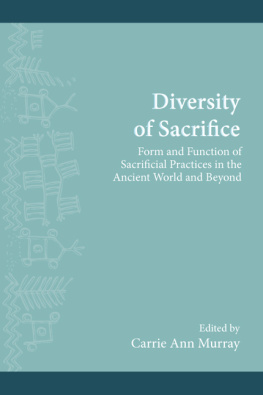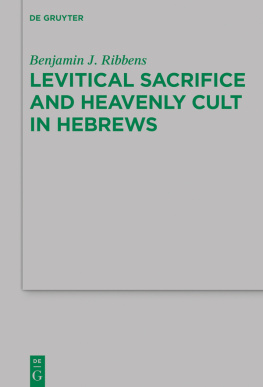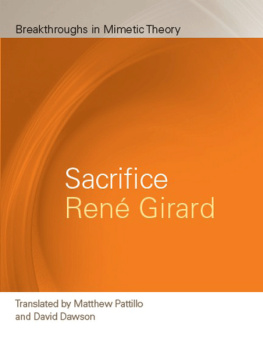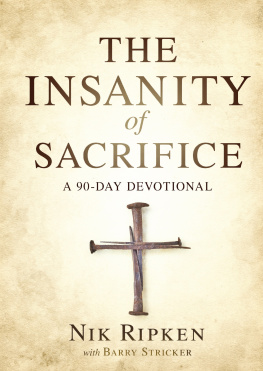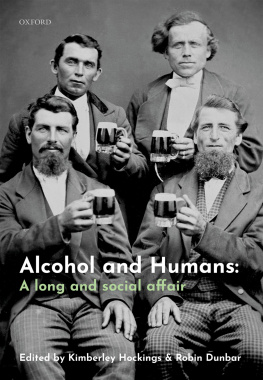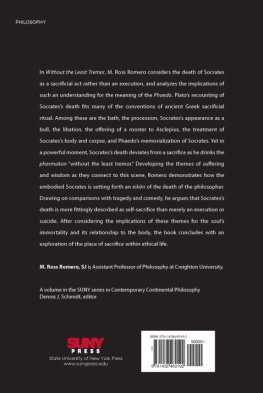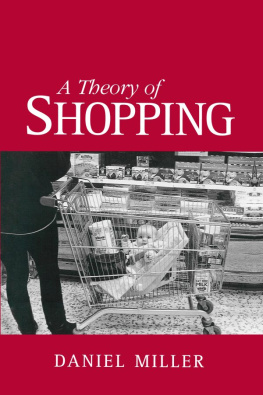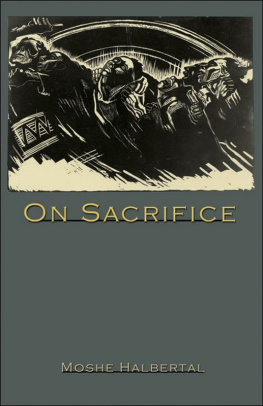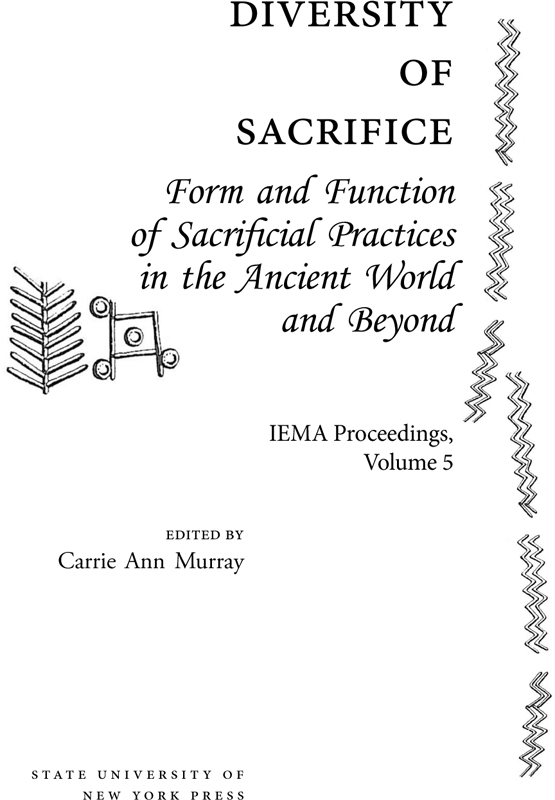Diversity of Sacrifice
THE INSTITUTE FOR EUROPEAN AND MEDITERRANEAN ARCHAEOLOGY
DISTINGUISHED MONOGRAPH SERIES
Peter F. Biehl, Sarunas Milisauskas, and Stephen L. Dyson, editors
The Magdalenian Household: Unraveling Domesticity
Ezra Zubrow, Franoise Audouze, and James G. Enloe, editors
Eventful Archaeologies: New Approaches to Social Transformation in the Archaeological Record
Douglas J. Bolender, editor
The Archaeology of Violence: Interdisciplinary Approaches
Sarah Ralph, editor
Approaching Monumentality in Archaeology
James. F. Osborne, editor
The Archaeology of Childhood: Interdisciplinary Perspectives on an Archaeological Enigma
Gner Cokunsu, editor
Diversity of Sacrifice: Form and Function of Sacrificial Practices in the Ancient World and Beyond
Carrie Ann Murray, editor
Logo and cover/interior art: A vessel with wagon motifs from Bronocice, Poland, 3400 B.C. Courtesy of Sarunas Milisauskas and Janusz Kruk, 1982, Die Wagendarstellung auf einem Trichterbecher au Bronocice, Polen, Archologisches Korrespondenzblatt 12: 141144
Published by
State University of New York Press, Albany
2016 State University of New York
All rights reserved
Printed in the United States of America
No part of this book may be used or reproduced in any manner whatsoever without written permission. No part of this book may be stored in a retrieval system or transmitted in any form or by any means including electronic, electrostatic, magnetic tape, mechanical, photocopying, recording, or otherwise without the prior permission in writing of the publisher.
For information, contact
State University of New York Press, Albany, NY
www.sunypress.edu
Production, Eileen Nizer
Marketing, Michael Campochiaro
Library of Congress Cataloging-in-Publication Data
Diversity of sacrifice : form and function of sacrificial practices in the ancient world and beyond / edited by Carrie Ann Murray.
pages cm. (SUNY series, The Institute for European and Mediterranean Archaeology distinguished monograph series)
Includes bibliographical references and index.
ISBN 978-1-4384-5995-0 (hardcover : alkaline paper)
ISBN 978-1-4384-5996-7 (e-book) 1. SacrificeEuropeHistoryTo 1500Congresses. 2. SacrificeMeditarranean RegionHistoryTo 1500Congresses. 3. Social archaeologyEuropeCongresses. 4. Social archaeologyMeditarranean RegionCongresses. 5. Archaeology and religionEuropeCongresses. 6. Archaeology and religionMeditarranean RegionCongresses. 7. Material cultureEuropeHistoryTo 1500Congresses. 8. Material cultureMeditarranean RegionHistoryTo 1500Congresses. 9. Social interactionEuropeHistoryTo 1500Congresses. 10. Social interactionMeditarranean RegionHistoryTo 1500Congresses. I. Murray, Carrie Ann, 1976 II. University of Buffalo. Institute for European and Mediterranean Archaeology.
| BL570.D58 2016 |
| 203'.40936dc23 | 2015013508 |
10 9 8 7 6 5 4 3 2 1
For my grandfather, Detective Louis Linton Miller,
who died while protecting the people of New York City
Contents
I NTRODUCTION
The Value and Power of Sacrifice
Carrie Ann Murray
P ART I
D EFINING AND R EDEFINING THE B OUNDARIES OF S ACRIFICE
C HAPTER O NE
Anthropology and Sacrifice
Phillips Stevens Jr.
C HAPTER T WO
A View from a Fen: On the Concept of Sacrifice and the Possibility of Understanding Neolithic Wetland Depositions
sa Berggren
C HAPTER T HREE
Gifts from the Gods: A New Look at Some Weapons and Vessels from the Metal Ages
Christoph Huth
C HAPTER F OUR
Post-Domestic Sacrifice: Exploring the Present and Future of Gifts for the Gods
Samantha Hurn
P ART II
S ACRIFICE A CROSS THE M EDITERRANEAN W ORLD
C HAPTER F IVE
Every Good and Pure Thing: Sacrifice in the Ancient Egyptian Context
Mary-Ann Pouls Wegner
C HAPTER S IX
The Mythology of Carthaginian Child Sacrifice: A Physical Anthropological Perspective
Jeffrey H. Schwartz
C HAPTER S EVEN
The Art of Ancient Greek Sacrifice: Spectacle, Gaze, Performance
Tyler Jo Smith
C HAPTER E IGHT
Etruscan Human Sacrifice: The Case of Tarquinia
Nancy T. de Grummond
P ART III
E XPLORING E XCEPTIONAL C ASES OF S ACRIFICE
C HAPTER N INE
Human Sacrifice as Crisis Management? The Case of the Early Neolithic Site of Herxheim, Palatinate, Germany
Andrea Zeeb-Lanz, Rose-Marie Arbogast, Silja Bauer, Bruno Boulestin, Anne-Sophie Coupey, Anthony Denaire, Fabian Haack, Christian Jeunesse, Dirk Schimmelpfennig, Rouven Turck
C HAPTER T EN
Dog Sacrifice at the Protohistoric Site of Mas Castellar (Ponts, Spain)
Enriqueta Pons, Ldia Colominas, Maria Saa
C HAPTER E LEVEN
Understanding the Death and Burial of Northern European Bog Bodies
Guinevere Granite
P ART IV
F ORMULARIZING AND R EGULARIZING S ACRIFICE
C HAPTER T WELVE
Sacrificing the Sign: The Alphabet as an Offering in Ancient Israel, or A Classicists Read on the Ritual Law of the Sotah
Roger D. Woodard
C HAPTER T HIRTEEN
Ancient Greek Laws on Sacrifice
Michael Gagarin
C HAPTER F OURTEEN
In What Way Is Christs Death a Sacrifice? Theories of Sacrifice and Theologies of the Cross
S. Mark Heim
Illustrations
I NTRODUCTION
The Value and Power of Sacrifice
 | Carrie Ann Murray |
I SSUES OF S ACRIFICE IN S CHOLARSHIP
A n experience that affects all of the sensesthe impetuses and consequences of sacrificial practices relate to more than purely religious considerations. The continuous presence of sacrifice, in widely varying forms, from ancient to contemporary contexts is testament to its perceived long-term significance. Its relevance applies to the community, family, and individual. Evidence from archaeology, epigraphy, ethnography, history, and literature provides a wealth of insights into a multitude of sacrificial practices from across a wide spectrum of contexts. There is an abundance of scholarship informing our understanding of sacrifice in its different guises. Publications often explore the significance of sacrifice within the confines of separate contexts: ancient, contemporary, pagan, Christian, and others. The isolated perspectives often reach little consensus regarding what seems so neatly packaged as a single term, sacrifice, in our parlance, but what is a complex and varied transhistorical and transcultural phenomenon.
To begin, let us consider how sacrifice can be defined. Sacrifice in the ancient world has been defined as a central act of Greek and Roman religious ritual, an offering to the gods, heroes, or the dead (Stafford 2006:775). Here, as elsewhere, the emphasis is placed on a means of gift giving from humans to the supernatural and the otherworldly. The recipients of sacrificedeities and the deceasedare very different in nature, but are combined in definitions of sacrifice to distinguish these practices from purely mundane and secular actions. Discussions of other aspects of sacrifice, such as scale, types of offerings, and procedures are subsumed within these descriptions. These variables can diverge wildly without affecting what is seen as the essence of sacrifice, allowing us to categorize different types of sacrifice, for instance: blood, bloodless, animal, human, civic, private, etc. Typologies of sacrifice, as with most attempts to rationalize and compartmentalize social action, come with benefits and limitations. Identifying different contexts and purposes has been fundamental. Yet, such fine-grained distinctions between sacrificial rites of different contexts can also obscure aspects of sacrifice that present continuities rather than oppositions.

